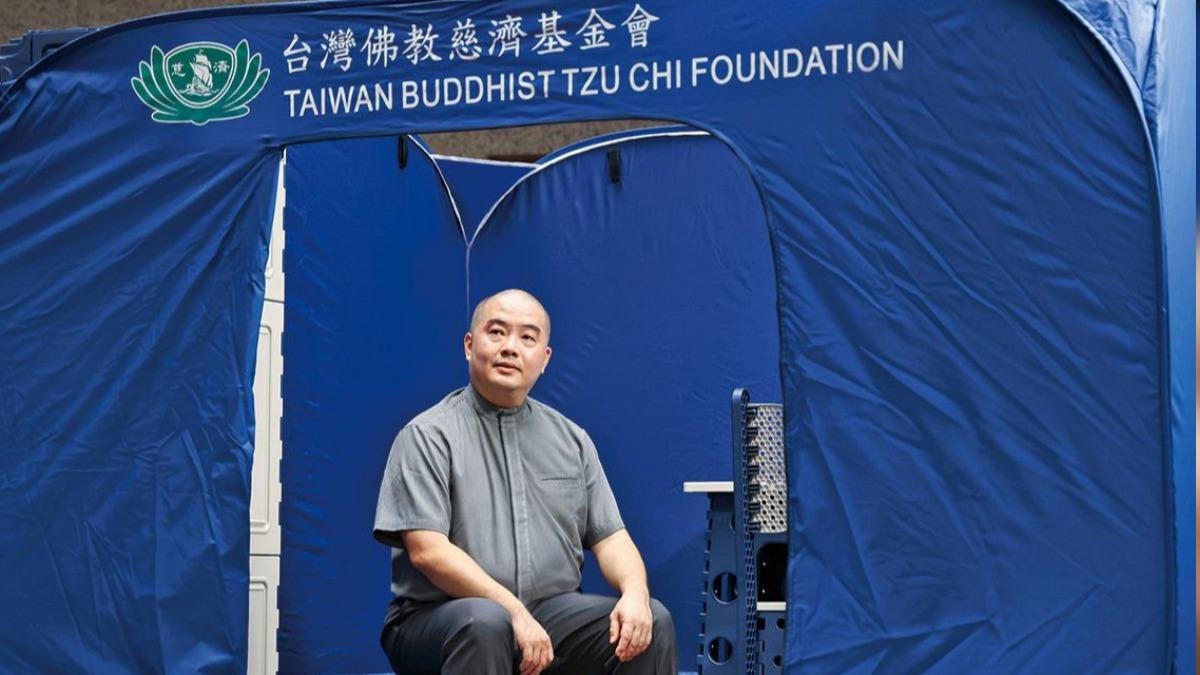TAIPEI (Business Today/TVBS News) — After the April 3 Hualien (花蓮) earthquake, the Tzu Chi Foundation (慈濟基金會) provided partition screens to ensure the privacy of evacuated disaster victims, astonishing Japanese social media users.
Tsai Sheng-lun (蔡昇倫), the inventor of the partition, gave an exclusive interview to Business Today, sharing the ingenious design behind it and his heartwarming stories from over twenty years of disaster relief work.
"Facing such a major disaster, sometimes the victims just want to cry out loud," Tsai, with his bald head and sincere demeanor, said, his tone filled with deep emotion. He spoke about his observations from over two decades of participating in domestic and international disaster relief work with the Tzu Chi Foundation. The reality is, they often don't even have a place to cry freely."
On April 3, Taiwan experienced its most severe earthquake since the 1999 Jiji earthquake, with a magnitude of 7.2, resulting in 13 deaths and over a thousand injuries. In Hualien County (花蓮縣), located at the epicenter, numerous high-rise buildings collapsed or tilted dangerously, forcing many residents to evacuate to school auditoriums and gymnasiums for shelter.
Two days after the earthquake, a scene from a Hualien shelter suddenly went viral in Japanese media, with the keyword "Taiwan shelter" topping Japan's top search list.
When Japanese reporters entered the gymnasium, they were surprised to find the spacious evacuation space neatly filled with blue and gray square partitions resembling tents, each equipped with two sets of bed frames, tables, and chairs, accommodating households of displaced victims. The Japanese were moved, not expecting that Taiwan could consider the privacy and dignity of disaster victims while providing emergency shelter services.
This invention, which amazed the Japanese, is the Jingsi Technology (淨斯科技) "Jing Si partition tents," mass-produced and provided by the foundation. The soul behind designing and providing humane resettlement services for disaster victims is Tsai, who became a Tzu Chi "monastic disciple" at the age of thirty and has an architectural background.

Architect Turned Inventor Wins Red Dot Design Award
Tsai, 47, is the director of Jingsi Technology, a company established by the Tzu Chi Foundation that specializes in designing and producing furniture and utensils for disaster relief made entirely from recycled waste. In addition to the widely noticed partition tents, the Jing Si multipurpose folding bed, tables, and chairs developed under Tsai's leadership have been extensively used in domestic and international disaster relief efforts. Among these, the folding bed won the product design award at the Red Dot Design Award (紅點設計大獎), one of the four major international design competitions, in 2014.
Each of these affirmed inventions stems from Tzu Chi's years of deep involvement in international disaster relief and the delicate observation and empathy for the situation of disaster victims.
The design of the Jing Si partition tents, which amazed Japan this time, originated from the devastating "Feb. 6 Earthquake" in 2018. Tsai recalled that, under the instructions of Master Cheng Yen, he went to the Hualien Stadium to inspect the situation of the disaster victims. During the visit, he opened photos he had taken at the time, showing Jing Si multipurpose folding bed scattered across the sports field, piled with supplies and blankets, with evacuated victims sitting on the beds like isolated islands.
"You can see, the environment was very chaotic," Tsai remembered. Upon learning of the situation on-site, Master Cheng Yen quickly proposed the idea, "Can we provide a bit more privacy for the victims?" Thus, he took on the task. After intensive discussions and improvements by the team, a year later, the Jing Si partition tents were developed to improve the quality of the resettlement environment effectively, and they were used on a large scale for the first time in this earthquake.
This set of environmental partitions, made from 280 recycled PET bottles, has a simple appearance but is full of ingenious designs. Tsai shared that the choice of gray and blue colors can stabilize the chaotic emotions of disaster victims. The dark color is not easily penetrated by light, also ensuring users' privacy. Moreover, with a height of 165 cm, the partition does not feel oppressive to users, and passersby cannot easily see inside. The length and width dimensions also allow easy access for wheelchair users.
"Some disaster victims have mobility issues and need to change diapers, while some parents need to breastfeed their children. Having a partition that provides privacy is especially important for them." At the disaster site in Hualien, victims from different backgrounds received considerate care under the empathetic design, which comforted their fragile hearts after the disaster. This firsthand feedback deeply impressed Tsai.
In fact, before inventing disaster relief facilities like the Jing Si multipurpose folding bed and Jing Si partition tents, Tsai was an architect who participated in the reconstruction after the 2003 Bam Earthquake in Iran and the 2004 Indian Ocean tsunami. Over the past two decades, he says he has always done the same thing: seeing the needs of disaster victims. With his clear eyes, he has been accustomed to observing the weak and empathizing with their suffering since he was young.
Tsai was born in 1977 in Luzon, Philippines, a Pacific nation composed of more than 7,000 islands long plagued by typhoons, earthquakes, and tsunamis. His father, Tsai Wan-lei (蔡萬擂), was the executive director of the Tzu Chi Foundation's Philippines branch at the time, often taking his four children to rural areas of the Philippines for medical relief. From a young age, Tsai was exposed to the disparities between rich and poor and the people’s suffering.
"Once, we visited a patient who had simply stepped on a piece of glass and got injured. Without timely treatment, his entire leg had to be amputated, and all the family's money went to medical expenses," Tsai lamented. "It was then that I truly understood what it means to be sick because of poverty and poor because of illness."
Recognizing the lack of medical resources, Tsai chose to study architecture in college, vowing to one day build hospitals for the poor in his homeland. After graduating from college and obtaining his architect's license, he first came to work at the Tzu Chi Foundation's Construction Department in Taiwan in 2000, not expecting that this stay would last for over twenty years.
Early in his career, Tsai participated in Tzu Chi's disaster relief and medical missions as an architect, assisting with several school reconstruction projects in Iran and Sri Lanka in 2003 and 2004. Domestically, he also helped Lin Hsin-jung (林欣榮), the director of Hualien Tzu Chi Hospital (花蓮慈濟醫院), set up a cGMP standard manufacturing laboratory. His diverse practical experience enabled him to successfully enroll in a master's program in healthcare architecture in the United Kingdom in 2005, further studying the integration, planning, and management of architectural work.
Compared to the general understanding of drawing and construction, he views the profession of an architect with a broader perspective: "An important job of an architect is to identify problems and design tangible solutions." After studying in the United Kingdom for three years and returning to Taiwan, his focus gradually shifted from simply "building houses" to using his expertise in design and planning to help Tzu Chi address the problems of the disadvantaged.
His first significant achievement was the "Jing Si multipurpose folding bed."
In 2010, during the Pakistan floods, the Tzu Chi team went to the area for disaster relief and found many children dressed in thin clothes forced to sleep on the damp ground. Under the guidance of Master Cheng Yen, Tsai began developing elevated bed frames to provide a more comfortable environment for the victims. The final product, a 15-kilogram, easily portable folding bed capable of supporting 150 kilograms, received several international design awards, including the Red Dot Design Award.
In November 2013, Typhoon Haiyan (強颱海燕) struck the Philippines, causing catastrophic destruction and officially killing over 6,000 people. Tsai's folding bed was first used in this disaster. Although he has not yet fulfilled his wish to build a hospital for the poor in the Philippines, his inventions have provided support for many vulnerable disaster victims.

Committed to using eco-friendly materials, design with empathy
From the designed bed, desk, and chairs to the upgraded version of the partition, this series of disaster relief furniture systems, referred to as "Compassionate Technology" by Tzu Chi, are all made from 100% recycled materials such as PET bottles and waste plastic. Tsai admits that insisting on using eco-friendly materials, from managing the source of recyclables to finding cooperating manufacturers, faced many challenges. However, committed to not increasing carbon emissions, he personally supervised the recycling and sorting at environmental protection stations across Taiwan and communicated with manufacturers to complete this daunting task.
Lin Hong-chan, the director of the Public Relations Department at the Tzu Chi Foundation, has known Tsai for many years. He smiled and said that Tsai had endured many hardships under Master Cheng Yen's training. Over time, he gradually internalized Master Cheng Yen's design considerations, which started with empathy. These inventions not only implement environmental protection but also provide a bit of warmth to disaster victims in their time of need.
During the interview, Tsai also discussed the "Fuhui Storage Cabinet," a product that has been developed but not yet revealed to the public. This foldable cabinet can store supplies for easy distribution and provides an additional layer of security for disaster victims who fear theft. It showcases another considerate design for those affected by disasters.
Allowing disaster victims to sleep peacefully, cry without worry, and feel safe and secure when they have nothing left, Tsai's eyes focus on the needs of the vulnerable. Through his inventions, he accompanies those who are on the brink, helping them navigate the most difficult paths.
Japanese people admire Taiwanese meticulousness and thoughtfulness
Tzu Chi Foundation provided Jing Si partition tents to help accommodate disaster victims. After Japanese media reports, the term "Japan completely defeated" (日本完敗) and the keyword "Taiwan Shelter" surged to the top of Japan’s search rankings.
The New York Times also reported on the tent design, emphasizing the importance of residents' privacy. Tzu Chi Foundation explained that the concept for such shelters originated from their disaster relief experience during the Hualien earthquake.
This article is excerpted from the April issue of Business Today Magazine; for more articles, please visit the Business Today website.
Here is the link to the Chinese story: 南亞海嘯、伊朗震災都有他身影 蔡昇倫讓災民安睡、有隱私 登日本熱搜的花蓮賑災隔屏 他發明的!










